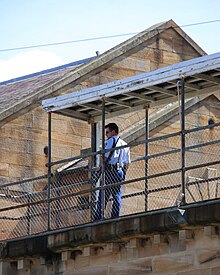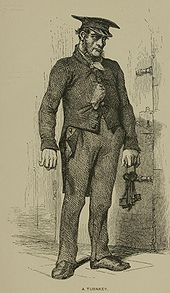Prison officer
 A prison guard on lookout in the watchtower at Parramatta Gaol | |
| Occupation | |
|---|---|
| Names |
|
Occupation type | Employment |
Activity sectors | Law enforcement |
| Description | |
| Competencies | See Working environment |
Education required | See Training |
Fields of employment | Prisons, jails |
Related jobs | Police officer |
A prison officer (PO) or corrections officer (CO), also known as a correctional law enforcement officer or less formally as a prison guard, is a uniformed law enforcement official responsible for the custody, supervision, safety, and regulation of prisoners. They are responsible for the security of the facility and its property as well as other law enforcement functions. Most prison officers or corrections officers are employed by the government of the jurisdiction in which they operate, although some are employed by private companies that provide prison services to the government.
Terms for the role
[edit]

Historically, terms such as "jailer" (also spelled "gaoler"), "guard" and "warder"[1] have all been used.
The term "prison officer" is used for the role in the UK[2] and Ireland.[3] It is the official English title in Denmark,[4] Finland,[5] Sweden[6] and Poland.[7]
The term "corrections officer" or "correction officer" is used in the U.S.[8][9] and New Zealand.[10]
The term "correctional police officer" or "CPO" is used in New Jersey. Due to the law enforcement status and authority of New Jersey's officers, New Jersey's officers employed by the Department of Corrections are classified as "police officers".[11][12]
Brazil has a similar system to New Jersey, but the officers are known as "state penal police agent" or "federal penal police agent".[13]
"Correctional officer" is used in Australia,[14] Canada,[15][16][17] Jamaica,[18] and the U.S.[19]
In Australia, prison officers were known as turnkeys until the 19th century after which they were known as warders until the late 20th century. Additionally, a slang term used as an insult or form of group endearment during this period was 'screws'. Following this period they were known as prison officers and later correctional officers.[20]
"Detention officer" is used in the U.S.,[21] as is the term "penal officer".[22]
The official who is in charge of a specific prison is known by various titles, including: "prison warden" (US and Canada), "governor" (UK and Australia), "superintendent" (South Asia) or "director" (New Zealand), respectively "Direktor" or "Gefängnisdirektor" (Germany).
Duties
[edit]The examples and perspective in this section may not represent a worldwide view of the subject. (March 2022) |

Prison officers must maintain order and daily operations of the facility and are responsible for the care, custody, and control of inmates. A correction officer has a responsibility to control inmates who may be dangerous, and that society themselves do not wish to accommodate. An officer must always prevent disturbances, assaults, and escapes by supervising activities and work assignments of inmates. Officers have a responsibility to protect themselves, other officers, inmates, and the public from assault by other inmates. Correctional officers must also protect inmates from harming themselves or committing suicide. An officer must be alert and aware of any and all movement taking place inside the facility.
Prevention is one of the key components of an officer's duties. Officers can utilize prevention by routinely searching inmates and their living quarters for potential threats such as weapons, drugs, or other contraband. Officers should remain assertive and in most situations refuse to back down. An officer shall hold offenders who violate facility policy accountable for their actions when rules are violated. This is usually done through on the spot corrections, a formal disciplinary process, or through the legal process in extreme circumstances. Correction officers must take full concern for the health and safety of the facility. Officers check for unsanitary conditions, fire hazards, and/or any evidence of tampering or damage to locks, bars, grilles, doors, and gates. Fire and severe weather drills may be common. Officers may screen all incoming and outgoing mail for select high risk offenders.
All prison staff, regardless of position, volunteers, visitors, new court commit, and offenders returning from off ground, are searched prior to entry. This aids in the reduction of contraband being introduced into the facility. These routine searches often employ hand held or walk through metal detectors, and baggage x-ray machines. Under certain instances, a canine, pat/frisk, full strip, and vehicle (if parked on facility grounds) search may be conducted. Correction officers are responsible for transporting inmates to other facilities, medical appointments, court appearances, and other approved locations. In the US, these trips are most often local, but may be across the entire country. Correction officers may assist police officers on/off duty depending on their peace officer status and jurisdiction.[23]
Training
[edit]Corrections officers' training will vary from jurisdiction to jurisdiction as well as facility to facility depending on the legislated power given, the nature of the facilities, or even the socioeconomics of the region. Training may be provided by external agencies or at the facility with a peer-group or supervisor instructor.
In North America, standard training usually includes:
- Use of force and restraints (i.e., handcuffs, leg-irons, belly-chains, etc.)
- Weapons (firearms, taser, pepper spray, baton, etc.)
- Self-defense
- First aid and CPR
- Report writing
- Giving testimony in court
- Defusing hostility
- Interpersonal communication
- Correction law
- Criminal law
- Criminal procedure law
- Case work and criminal investigations
- Hostage negotiation
- Gang intelligence
- Cross gender supervision
Many jurisdictions have also, in recent years, expanded basic training to include:
- Suicide prevention/crisis intervention
- Mental health awareness
- Critical incident stress management
- Occupational Safety and Health Act (U.S.) or Workplace Hazardous Materials Information System (Canada)
- Gang awareness and intervention
- Crisis or hostage negotiation
- Drug abuse training
- Rehabilitation programs
- Rapid response training
- Prison Rape Elimination Act of 2003 (PREA)
- Diversity, equity, and inclusion (DEI)
- Staff wellness
Most institutions in the United States have a crisis resolution team of some sort, though these vary in name (i.e., Crisis Resolution Team or CRT, Special Response Team or SRT, Critical Incident Response Team or CIRT, Correctional Emergency Response Team or CERT, Crisis and Emergency Response Team also CERT, Correctional Emergency Unit or CEU, Special Security Team or SST, Disturbance Control Team or DCT, Special Operations And Response Team or SORT, and Tactical Support Unit or TSU). These teams take on a role similar to a police SWAT or Special Weapons and Tactics team, but are tailored to the prison setting. Though these vary greatly from jurisdiction to jurisdiction, they typically must pass a very physically and mentally demanding tactical academy or training course, often lasting a week or more. Special units must qualify regularly and at shorter intervals than regular line staff to remain in the specialized position. They must also score in the 90th percentile or better of the standard scoring systems.
See also
[edit]References
[edit]- ^ "warder, n.1". Oxford English Dictionary (Online ed.). Oxford University Press. (Subscription or participating institution membership required.)
- ^ "Working for HMPS". UK Government. Retrieved 18 November 2015.
- ^ Irish Prison Service – Recruitment Archived 17 June 2011 at the Wayback Machine. Retrieved 29 November 2011
- ^ The Danish Prison and Probation Service – General Information, page 5 Archived 17 March 2014 at the Wayback Machine Retrieved 2012-07-07
- ^ The Training Institute for Prison and Probation Services, Finland Archived 5 December 2011 at the Wayback Machine Retrieved 29 November 2011
- ^ Swedish Prison and Probation Service – Fact Sheet. Retrieved 29 November 2011
- ^ Compendium for foreign nationals on remand, convicted or punished
- ^ Indeed: Corrections Officer Salary Retrieved 2012-07-07
- ^ Yukon Department of Justice website Retrieved 29 November 2011
- ^ New Zealand Department of Corrections – Job Description Archived 5 October 2012 at the Wayback Machine. Corrections.govt.nz Retrieved 29 November 2011
- ^ NJ Civil Service: Correctional Police Officer Retrieved 2021-06-13
- ^ NJ Civil Service: County Correctional Police Officer Retrieved 2021-06-13
- ^ Junior, Janary (6 July 2024). "Promulgada emenda constitucional que cria Polícia Penal, para atuar no sistema prisional". Câmara dos Deputados. Retrieved 6 July 2024.
- ^ Queensland Corrective Services – Employment Information Retrieved 2012-07-07
- ^ Correctional Service Canada – Correctional officer job profile Archived 24 August 2011 at the Wayback Machine Retrieved 29 November 2011
- ^ Ontario Correctional Services – Careers Retrieved 29 November 2011
- ^ British Columbia Corrections – Employment Information Retrieved 29 November 2011
- ^ Jamaica Department of Correctional Service – Roles of Correctional Officer Archived 21 September 2011 at the Wayback Machine Retrieved 29 November 2011
- ^ US Department of Labor – Correctional Officer job statistics Retrieved 29 November 2011
- ^ Dawson, Christopher. "Screw!". Inside Boggo Road. Boggo Road Gaol Historical Society. Archived from the original on 27 January 2023. Retrieved 27 January 2023.
- ^ FBI Atlanta: Former Fulton County Detention Officer Sentenced to 10 Years in Federal Prison Retrieved 2012-07-07
- ^ Career Occupational Profile for: Penal Officer Retrieved 2014-03-17
- ^ "Occupational Outlook Handbook, 2010–11 Edition". Archived from the original on 28 June 2011. Retrieved 25 June 2011.
Further reading
[edit]- Correctional Service of Canada. Correctional Officers and Their First Year: An Empirical Investigation
- Davenport, D. K. (2001). State of Arizona Office of the Auditor General Performance Audit: Arizona Department of Corrections. Sunset Factors Retrieved 8 March 2008 from http://www.auditorgen.state.az.us/Reports/State_Agencies/Agencies/Corrections[permanent dead link]
- Tracy, S. J. (2004). The construction of correctional officers: Layers of emotionality behind bars. Qualitative Inquiry, 10, 509–533.
- Tracy, S. J., Meyers, K., & Scott, C. (2007). Cracking jokes and crafting selves: Sensemaking and identity management among human service workers. Communication Monographs, 73, 283–308.
External links
[edit] Media related to Prison guards at Wikimedia Commons
Media related to Prison guards at Wikimedia Commons